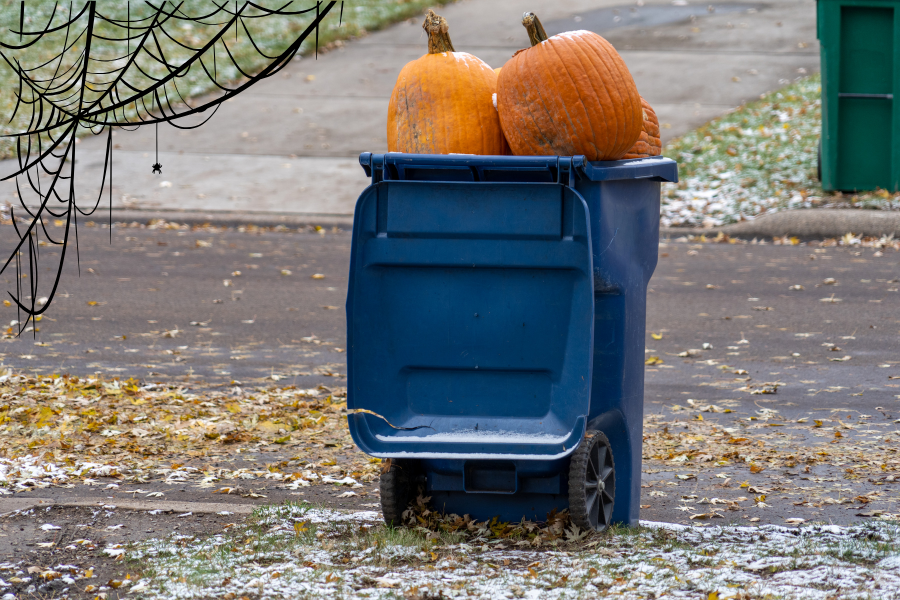The Scariest Part of Halloween Isn’t the Monsters—It’s the Waste
By Ruby Rañoa, Earth Forward Group
Published October 17 2025
The information provided in this article is for informational purposes only. Earth Forward Group is not affiliated with, endorsed by, or compensated by any of the companies, products, or websites mentioned herein. We do not guarantee the accuracy, suitability, or performance of any referenced websites or products.
The real fright this Halloween is not the monster under your bed, but the mountains of trash that haunt our planet long after October 31st passes. From plastic-wrapped candies, single-use costumes, and cheap decorations destined for the landfill, the holiday can take a massive toll on the environment.
But it does not have to be this way! The only thing that should be terrifying is your costume, not your carbon footprint. With a few easy swaps and habit changes, you can make sustainability part of the Halloween spirit—no spells required.
Costumes
Crops and climate change have a complicated relationship. On one hand, warmer temperatures have led to longer growing seasons and increased precipitation in some areas, which could improve some crop conditions. On the other, heatwaves, drought, wildfires, and storms in some areas can damage crops. Furthermore, increased temperatures can expand the range of insects, weeds, and crop diseases, all harming crop yield.
However, climate change is anticipated to decrease food security overall, while prices rise. The nutritional value of crops, many crop yields, livestock, and fish production are all expected to decline, contributing to worsening food and nutritional security.
Photo by Paige Cody on Unsplash
Making your own costumes is always a great option! You can raid your own closet or head to your local thrift store for the base of your costume. Whether you have impressive seamstress skills or just some cardboard and a dream, there are achievable costumes out there for everyone. Check out these unique DIY costume ideas for all ages.
If you’re not feeling crafty, local thrift stores have plenty of options for secondhand Halloween costumes. Alternatively, you could purchase handmade costumes from local businesses or small shops on Etsy to support small businesses.
Trick-or-Treating
If you are venturing out to trick-or-treat this year, use a reusable bag that you already own, such as a tote bag, basket, or the classic pillowcase. To reduce travel emissions, consider staying local and trick-or-treating in your own neighborhood. If you’re headed elsewhere, choose lower impact options like public transportation, carpooling, or biking.
If you’re staying home to hand out candy to trick-or-treaters, try to buy plastic-free options whenever possible. For example, some candies come in cardboard boxes, paper wrappers, or foil wrappers.
But buyers beware! Not all candy is created ethically. Known problems in the candy industry include unethical labor practices such as child labor, forced labor, and/or low wages; negative environmental impact through the harvesting of palm oil, deforestation, and harmful farming practices; and lack of transparency and traceability in the production process. When buying candy, look for certifications such as Fair Trade Certified™, Rainforest Alliance, and Fair for Life and choose palm oil-free options to make your Halloween more sustainable.
“When you buy fair trade, you’re not just picking a sweet; you’re contributing to fair wages, community development, and better working conditions for farmers.”
Seasonal Decorations
Photo by Mark König on Unsplash
Each year, consumers spend approximately $2.4 billion on plastic decorations that end up in landfills. The best way to combat this is by reusing the seasonal decorations you already own or swapping decorations with friends, family, and neighbors to keep your decor fresh. If you are in need of seasonal decor, try checking the thrift store first!
Photo by Ksenia Yakovleva on Unsplash
You can also decorate for the season using natural elements such as pumpkins or a DIY twig wreath, both of which can be composted after autumn ends.
If the fall season demands for candles, opt for candles made with soy wax and/or beeswax over candles made with paraffin wax. Paraffin wax is petroleum-based and is a byproduct of the oil purification process. A 2009 study found that paraffin wax emitted toluene and benzene fumes when lit, which have been linked to respiratory issues such as asthma and lung cancer. Natural wax options, such as soy and beeswax, offer safer alternatives to candle-lovers.
Parties
If you are hosting a Halloween party this season, opt for reusable dishes and serving ware or compostable paper and wood options. Instead of individually wrapped candies, serve homemade or locally-sourced treats with minimal packaging such as cookies and other baked goods.
This Halloween, small habit changes can make a world of difference. By swapping costumes with your friends, reusing seasonal decorations, choosing plastic-free candy, and opting for reusable or compostable dishware at parties, you can help decrease the holiday’s environmental impact, while still celebrating. The Earth Forward Group team wishes you all a safe and sustainable Halloween!
Are you already thinking of the winter holiday season? Check out our article on How to Shop Mindfully this Holiday Season.





